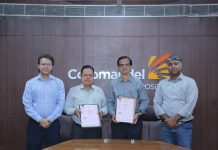Twin breakthroughs by researchers at King Abdullah University of Science and Technology (KAUST), Thuwal, Saudi Arabia, overcome two issues holding back development of microbial electro-synthesis (MES) technology. MES involves using electrical currents to stimulate microorganisms into manufacturing useful chemical products.
The team harvested the ability of chemolithoautotrophs, microbes that resides in places where energy sources such as sunlight and organic carbon are in short supply and consume CO2 through their natural metabolism, creating small organic molecules as a by-product. The idea itself wasn’t new as many research projects have focused on MES. However, the typical MES reactor uses chemolithoautotrophs grown on a submerged flat-sheet cathode, with CO2 then bubbled into the solution. According to team member Manal Alqahtani, this has two key problems: flat-sheet cathodes are difficult to scale up, and CO2 gas has poor solubility.
So, the team developed an alternative MES reactor using cathodes made from stackable, cylindrical porous nickel fibers that Saikaly’s group previously applied to recover water and energy from wastewater. Here, CO2 is pumped through each cylinder, and electrons flow along it.
In Alqahtani’s initial study, the porous nickel hollow fibers act as an inorganic electrocatalyst for hydrogen generation from proton reduction and as a gas‐transfer membrane for direct CO2 delivery to CO2‐fixing hydrogenotrophic methanogens (biological catalysts) on the cathode. These novel features create a suitable environment for the enrichment of methanogens, which utilize the hydrogen as a source of reducing equivalents for converting CO2 to methane. The microbes were able to convert CO2 to methane with 77% efficiency, compared to 3% efficiency with a conventional MES design.
The thinking here is to improve both biofilm formation on the cathode and product generation rates, the cathode design needs a high specific surface area and enhanced electrode-microbe electron transfer. This study aimed to demonstrate a novel cathode design made of porous nickel hollow fibers (Ni-PHFs). The pores in these hollow fibers facilitate direct delivery of CO2 to the bacteria Sporomusa ovata in MES.
Modifying the surface of Ni-PHFs with carbon nanotubes (CNTs) resulted in an 11-fold increase in the CO2 adsorption capability at atmospheric pressure, as well as 76.3% reduction of cathode electron transfer resistance. These results demonstrate that using the PHF electrode design and modifying the cathode morphology to enhance the microbe-electrode interactions and CO2 availability for bacterial growth are effective approaches to increase the rates of CO2 reduction in MES, the team notes.
Further the team is investigating easier approaches to develop porous cylindrical cathodes, while optimizing CO2 flow rates and investing in renewable MES energy sources, such as solar.

































